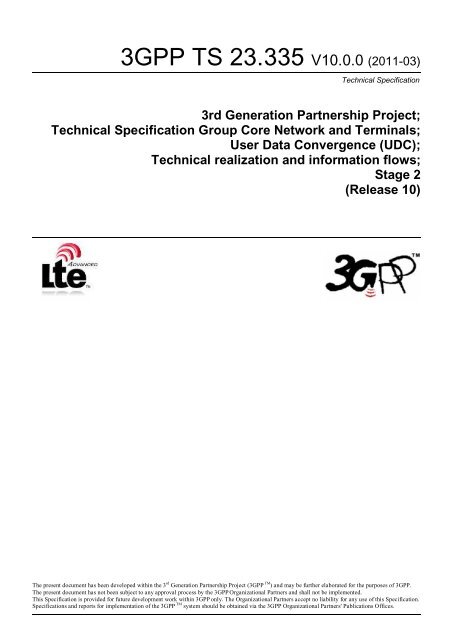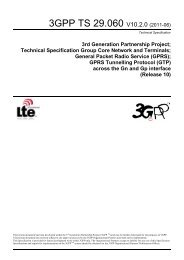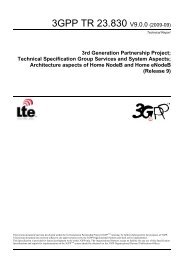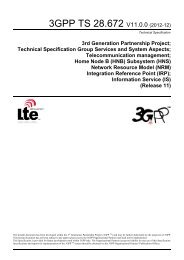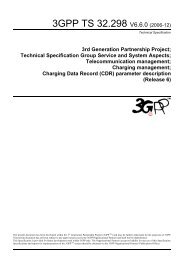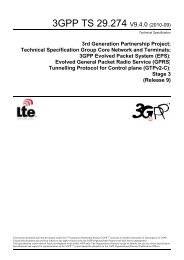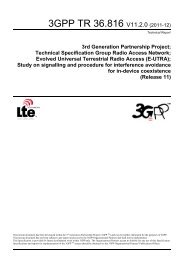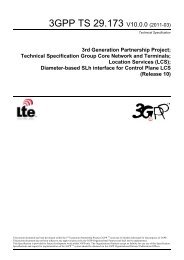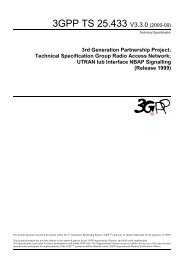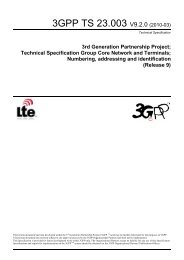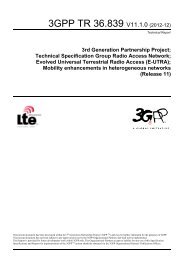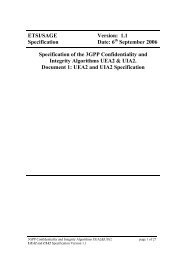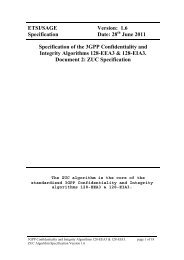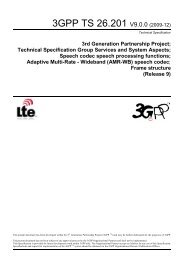3GPP TS 23.335 V10.0.0 (2011-03)
3GPP TS 23.335 V10.0.0 (2011-03)
3GPP TS 23.335 V10.0.0 (2011-03)
You also want an ePaper? Increase the reach of your titles
YUMPU automatically turns print PDFs into web optimized ePapers that Google loves.
<strong>3GPP</strong> <strong>TS</strong> <strong>23.335</strong> <strong>V10.0.0</strong> (<strong>2011</strong>-<strong>03</strong>)<br />
Technical Specification<br />
3rd Generation Partnership Project;<br />
Technical Specification Group Core Network and Terminals;<br />
User Data Convergence (UDC);<br />
Technical realization and information flows;<br />
Stage 2<br />
(Release 10)<br />
The present document has been developed within the 3 rd Generation Partnership Project (<strong>3GPP</strong> TM ) and may be further elaborated for the purposes of <strong>3GPP</strong>.<br />
The present document has not been subject to any approval process by the <strong>3GPP</strong> Organizational Partners and shall not be implemented.<br />
This Specification is provided for future development work within <strong>3GPP</strong> only. The Organizational Partners accept no liability for any use of this Specification.<br />
Specifications and reports for implementation of the <strong>3GPP</strong> TM system should be obtained via the <strong>3GPP</strong> Organizational Partners' Publications Offices.
Release 10<br />
2<br />
<strong>3GPP</strong> <strong>TS</strong> <strong>23.335</strong> <strong>V10.0.0</strong> (<strong>2011</strong>-<strong>03</strong>)<br />
Keywords<br />
GSM, UM<strong>TS</strong>, network, IP, Multimedia MAP, IN<br />
<strong>3GPP</strong><br />
Postal address<br />
<strong>3GPP</strong> support office address<br />
650 Route des Lucioles - Sophia Antipolis<br />
Valbonne - FRANCE<br />
Tel.: +33 4 92 94 42 00 Fax: +33 4 93 65 47 16<br />
Internet<br />
http://www.3gpp.org<br />
Copyright Notification<br />
No part may be reproduced except as authorized by written permission.<br />
The copyright and the foregoing restriction extend to reproduction in all media.<br />
© <strong>2011</strong>, <strong>3GPP</strong> Organizational Partners (ARIB, ATIS, CCSA, E<strong>TS</strong>I, TTA, TTC).<br />
All rights reserved.<br />
UM<strong>TS</strong> is a Trade Mark of E<strong>TS</strong>I registered for the benefit of its members<br />
<strong>3GPP</strong> is a Trade Mark of E<strong>TS</strong>I registered for the benefit of its Members and of the <strong>3GPP</strong> Organizational Partners<br />
LTE is a Trade Mark of E<strong>TS</strong>I currently being registered for the benefit of its Members and of the <strong>3GPP</strong> Organizational Partners<br />
GSM® and the GSM logo are registered and owned by the GSM Association<br />
<strong>3GPP</strong>
Release 10<br />
3<br />
<strong>3GPP</strong> <strong>TS</strong> <strong>23.335</strong> <strong>V10.0.0</strong> (<strong>2011</strong>-<strong>03</strong>)<br />
Contents<br />
Foreword ...................................................................................................................................................... 5<br />
Introduction .................................................................................................................................................. 5<br />
1 Scope .................................................................................................................................................. 5<br />
2 References .......................................................................................................................................... 5<br />
3 Definitions, symbols and abbreviations ............................................................................................... 6<br />
3.1 Definitions ................................................................................................................................................... 6<br />
3.2 Symbols ....................................................................................................................................................... 7<br />
3.3 Abbreviations............................................................................................................................................... 7<br />
4 User Data Convergence architecture .................................................................................................... 7<br />
4.1 UDC System architecture ............................................................................................................................. 7<br />
4.2 Functional Entities ....................................................................................................................................... 9<br />
4.2.1 Application Front Ends ........................................................................................................................... 9<br />
4.2.2 Provisioning Front Ends .......................................................................................................................... 9<br />
4.2.3 User Data Repository ............................................................................................................................ 10<br />
4.2.4 Other Network Elements ....................................................................................................................... 10<br />
4.3 Reference point Ud .................................................................................................................................... 11<br />
4.4 Front-End Session ...................................................................................................................................... 11<br />
4.5 UDR Session ............................................................................................................................................. 11<br />
5 User Data convergence information flows ......................................................................................... 12<br />
5.1 General ...................................................................................................................................................... 12<br />
5.2 Requirements ............................................................................................................................................. 14<br />
5.3 Querying data from the UDR ...................................................................................................................... 15<br />
5.4 Creating data within the UDR..................................................................................................................... 16<br />
5.5 Deleting data from the UDR ....................................................................................................................... 17<br />
5.6 Updating data within the UDR.................................................................................................................... 18<br />
5.7 Subscription to Notifications ...................................................................................................................... 19<br />
5.8 Notification of data modification ................................................................................................................ 20<br />
5.8.1 Description ........................................................................................................................................... 20<br />
5.8.2 Notifications and transactions ............................................................................................................... 22<br />
Annex A (informative): Information flows ....................................................................................... 22<br />
A.0 Introduction ...................................................................................................................................... 22<br />
A.1 Information flows with Query data procedure over Ud ...................................................................... 22<br />
A.1.1 General ...................................................................................................................................................... 22<br />
A.1.2 CS terminating call information flow example ............................................................................................ 22<br />
A.1.3 IMS re-registration information flow example ............................................................................................ 23<br />
A.2 Information flows with Updating data procedure over Ud.................................................................. 24<br />
A.2.1 General ...................................................................................................................................................... 24<br />
A.2.2 CS location update information flow example ............................................................................................. 25<br />
A.2.3 IMS service data change information flow example .................................................................................... 26<br />
A.3 Example Information flows for subscriptions to notifications ............................................................ 27<br />
A.3.1 General ...................................................................................................................................................... 27<br />
A.3.2 Application Server Subscription information flow example ......................................................................... 27<br />
A.4 Information flows with notification procedure over Ud ..................................................................... 28<br />
A.4.1 General ...................................................................................................................................................... 28<br />
A.4.2 IMS user capability change with notification information flow example ...................................................... 29<br />
A.4.3 Application Server Notification information flow example without Ud-Notify ............................................ 30<br />
A.4.4 Application Server Notification information flow example with Ud-Notify ................................................. 31<br />
A.4.5 Application Server Notification information flow example without Ud-Notify – Subscription expired ......... 32<br />
A.4.6 Application Server Notification information flow example with Ud-Notify – Subscription expired .............. 33<br />
<strong>3GPP</strong>
Release 10<br />
4<br />
<strong>3GPP</strong> <strong>TS</strong> <strong>23.335</strong> <strong>V10.0.0</strong> (<strong>2011</strong>-<strong>03</strong>)<br />
Annex B (informative): Applicability of the UDC concept to network nodes ................................. 34<br />
B.1 Introduction .......................................................................................................................................... 34<br />
B.2 Basic Prerequisite ................................................................................................................................. 34<br />
B.3 Step 1 – Separating User Data from Application Logic ......................................................................... 34<br />
B.4 Step 2 – Introducing Provisioning FEs .................................................................................................. 35<br />
B.5 Step 3 - Storing outsourced user data in a logically single UDR ............................................................ 35<br />
B.6 Step 4 –Full Load Sharing and Failover functionality............................................................................ 36<br />
B.7 Step 5 – Converging user data in the UDR ............................................................................................ 37<br />
B.8 Example analysis for HLR .................................................................................................................... 37<br />
B.9 Example analysis for S-CSCF............................................................................................................... 37<br />
B.10 Example analysis for PCRF and SPR .................................................................................................. 38<br />
B.11 Summary ............................................................................................................................................ 38<br />
Annex C (informative): Change history .......................................................................................... 39<br />
<strong>3GPP</strong>
Release 10<br />
5<br />
<strong>3GPP</strong> <strong>TS</strong> <strong>23.335</strong> <strong>V10.0.0</strong> (<strong>2011</strong>-<strong>03</strong>)<br />
Foreword<br />
This Technical Specification has been produced by the 3 rd Generation Partnership Project (<strong>3GPP</strong>).<br />
The contents of the present document are subject to continuing work within the <strong>TS</strong>G and may change following formal<br />
<strong>TS</strong>G approval. Should the <strong>TS</strong>G modify the contents of the present document, it will be re-released by the <strong>TS</strong>G with an<br />
identifying change of release date and an increase in version number as follows:<br />
Version x.y.z<br />
where:<br />
x the first digit:<br />
1 presented to <strong>TS</strong>G for information;<br />
2 presented to <strong>TS</strong>G for approval;<br />
3 or greater indicates <strong>TS</strong>G approved document under change control.<br />
y the second digit is incremented for all changes of substance, i.e. technical enhancements, corrections, updates,<br />
etc.<br />
z the third digit is incremented when editorial only changes have been incorporated in the document.<br />
Introduction<br />
The UDC concept (<strong>3GPP</strong> <strong>TS</strong> 22.101 [3]) supports a layered architecture, separating the data from the application logic<br />
in the <strong>3GPP</strong> system, so that user data is stored in a logically unique repository allowing access from core and service<br />
layer entities, named Application Front Ends.<br />
Network elements and functionalities should be designed to access user data remotely and without storing them<br />
permanently locally, i.e. the Front Ends shall work in a subscriber dateless configuration.<br />
1 Scope<br />
The present document describes the procedures and signalling flows associated to the technical realization of the <strong>3GPP</strong><br />
User Data Convergence (UDC). It furthermore indicates some requirements for the stage 3 specifications.<br />
Special consideration is put in the following areas:<br />
- reference architecture for the UDC concept<br />
- general description of procedures for the user data manipulation (e.g. create, delete, update, etc.)<br />
- identification of the requirements on the UDC for the applicability of the mechanisms described in this document.<br />
User data convergence is an optional concept to ensure data consistency and simplify creation of new services by<br />
providing easy access to the user data, as well as to ensure the consistency of storage and data models and to have<br />
minimum impact on traffic mechanisms, reference points and protocols of network elements.<br />
2 References<br />
The following documents contain provisions which, through reference in this text, constitute provisions of the present<br />
document.<br />
<strong>3GPP</strong>
Release 10<br />
6<br />
<strong>3GPP</strong> <strong>TS</strong> <strong>23.335</strong> <strong>V10.0.0</strong> (<strong>2011</strong>-<strong>03</strong>)<br />
- References are either specific (identified by date of publication, edition number, version number, etc.) or<br />
non-specific.<br />
- For a specific reference, subsequent revisions do not apply.<br />
- For a non-specific reference, the latest version applies. In the case of a reference to a <strong>3GPP</strong> document (including<br />
a GSM document), a non-specific reference implicitly refers to the latest version of that document in the same<br />
Release as the present document.<br />
[1] <strong>3GPP</strong> TR 21.905: "Vocabulary for <strong>3GPP</strong> Specifications".<br />
[2] <strong>3GPP</strong> TR 22.985: "Service requirement for the User Data Convergence (UDC)".<br />
[3] <strong>3GPP</strong> <strong>TS</strong> 22.101: "Service aspects; Service principles".<br />
[4] <strong>3GPP</strong> <strong>TS</strong> 29.002: "Mobile Application Part (MAP) specification".<br />
[5] <strong>3GPP</strong> <strong>TS</strong> 23.002: "Network architecture".<br />
[6] <strong>3GPP</strong> <strong>TS</strong> 32.182: "User Data Convergence (UDC); Common Baseline Information Model<br />
(CBIM)".<br />
[7] <strong>3GPP</strong> <strong>TS</strong> 33.210: "3G Security; Network Domain Security; IP network layer security".<br />
[8] <strong>3GPP</strong> <strong>TS</strong> 32.181: "Telecommunication management; User Data Convergence (UDC); Framework<br />
for Model Handling and Management".<br />
3 Definitions, symbols and abbreviations<br />
3.1 Definitions<br />
For the purposes of the present document, the terms and definitions given in <strong>3GPP</strong> TR 21.905 [1] and the following<br />
apply. A term defined in the present document takes precedence over the definition of the same term, if any, in <strong>3GPP</strong><br />
TR 21.905 [1].<br />
Front End: a core network functional entity or service layer entity or provisioning entity that can access user data<br />
stored in a unique repository.<br />
Front End Identifier: A name that uniquely identifies an FE within the set of all FEs accessing an UDR.<br />
Front End Cluster: FEs handling the same application may be grouped in clusters to differentiate between them e.g.<br />
with regard to geographical location, feature support, vendor, or other characteristics. All FEs within a cluster are<br />
treated equally for required purposes (e.g. authorization, notifications, etc.).<br />
Application type: The application handled by a FE (e.g. HLR) determines the application type of the FE. The<br />
application type is derived from the name indicated by a FE.<br />
Front End Cluster Identifier: A name that identifies a cluster grouped with FEs supporting the same application.<br />
User Data Repository: facility where user data can be accessed stored and managed in a common way.<br />
Transaction: a transaction is a sequence of operations towards the User Data Repository (one or several), performed as<br />
a single logical unit of work. A logical unit of work must exhibit four properties, called the ACID (Atomicity,<br />
Consistency, Isolation, and Durability) properties, to qualify as a transaction.<br />
A transaction usually consists of the following steps, start transaction, making updates, and end of transaction; the<br />
transaction can finish successfully, in that case it is said the updated data is committed, or unsuccessfully, in that case<br />
the transaction is cancelled and the updates made till that moment are rolled back so that the data remains as it were<br />
before the transaction.<br />
Atomicity: a transaction must be an atomic unit of work; either all of its data modifications are performed or none of<br />
them is performed.<br />
<strong>3GPP</strong>
Release 10<br />
7<br />
<strong>3GPP</strong> <strong>TS</strong> <strong>23.335</strong> <strong>V10.0.0</strong> (<strong>2011</strong>-<strong>03</strong>)<br />
Consistency: when completed, a transaction must leave all data in a consistent state. In the User Data Repository, all<br />
rules must be applied to the transaction’s modifications to maintain all data integrity. All internal data structures must<br />
be correct at the end of the transaction.<br />
Isolation: modifications made by concurrent transactions must be isolated from the modifications made by any other<br />
concurrent transactions. A transaction either sees data in the state it was in before another concurrent transaction<br />
modified it, or it sees the data after the second transaction has completed, but it does not see an intermediate state. This<br />
is referred to as serialization because it results in the ability to reload the starting data and replay a series of transactions<br />
to end up with the data in the same state it was in after the original transactions were performed.<br />
Durability: after a transaction has completed, its effects are permanently in place in the User Data Repository. The<br />
modifications persist even in the event of a system failure.<br />
3.2 Symbols<br />
For the purposes of the present document, the following symbols apply:<br />
Ud<br />
3.3 Abbreviations<br />
reference point between a FE and the UDR<br />
For the purposes of the present document, the abbreviations given in TR 21.905 [1] and the following apply. An<br />
abbreviation defined in the present document takes precedence over the definition of the same abbreviation, if any, in<br />
<strong>3GPP</strong> TR 21.905 [1].<br />
FE<br />
UDC<br />
UDR<br />
Front End<br />
User Data Convergence<br />
User Data Repository<br />
4 User Data Convergence architecture<br />
4.1 UDC System architecture<br />
Figure 4.1-1 presents the reference UDC architecture. UDC is the logical representation of the layered architecture that<br />
separates the user data from the application logic, so that user data is stored in a logically unique repository allowing<br />
access from entities handling an application logic, hereby named Application Front Ends.<br />
In the architecture, the User Data Repository (UDR) is a functional entity that acts as a single logical repository of user<br />
data and is unique from Application Front End’s perspective. Entities which do not store user data and that need to<br />
access user data stored in the UDR are collectively known as application front ends.<br />
NOTE:<br />
Depending on the different network deployment, there may be more than one UDC in an operator’s<br />
network.<br />
Application Front Ends connect to the UDR through the reference point named Ud to access user data.<br />
Reference points towards network elements are marked in discontinuous lines in Figure 4.1-1, and are just shown for<br />
information purposes only. Details of the roles of these functional entities are described in sections 4.2.1, 4.2.2, 4.2.3<br />
and 4.2. 4.<br />
<strong>3GPP</strong>
Release 10<br />
8<br />
<strong>3GPP</strong> <strong>TS</strong> <strong>23.335</strong> <strong>V10.0.0</strong> (<strong>2011</strong>-<strong>03</strong>)<br />
Figure 4.1-1: UDC reference architecture<br />
Figure 4.1-2 shows how the UDC reference architecture is related to the overall network architecture by comparing a<br />
Non-UDC Network with an UDC Network. In the non-UDC Network, the figure shows NEs with their own database<br />
storing persistent user data and a NE accessing an external database; in both cases, when UDC architecture is<br />
applied, the persistent user data are moved to the UDR and concerned NEs are becoming Application-FEs (NE-FEs)<br />
according to the UDC architecture. This figure also shows that network interfaces between NEs are not impacted .A<br />
Network Element (NE), which in its original form represents application logic with persistent data storage, when the<br />
UDC architecture is applied, may become a NE Front End, since the related persistent data storage is moved to the<br />
UDR.<br />
<strong>3GPP</strong>
Release 10<br />
9<br />
<strong>3GPP</strong> <strong>TS</strong> <strong>23.335</strong> <strong>V10.0.0</strong> (<strong>2011</strong>-<strong>03</strong>)<br />
Figure 4.1-2: Comparison Non-UDC Network to UDC Network<br />
4.2 Functional Entities<br />
4.2.1 Application Front Ends<br />
Functional entities, such as the HLR/HSS/AUC, Application Servers, Access Network Discovery and Selection<br />
Function in Home Network (H-ANDSF), any other Core Network nodes, Provisioning system, etc., when the UDC<br />
architecture is applied, keep the application logic, but they do not locally store user data permanently. These data-less<br />
functional entities are collectively known in the UDC architecture as Application Front Ends. The application that is<br />
handled by an FE determines the type of FE. A HSS Front End may implement a full or a part of the HSS<br />
functionalities as listed in <strong>3GPP</strong> <strong>TS</strong> 23.002 [5], this choice being implementation dependant. The reference points<br />
between the different Front Ends and the core and service layers are not affected by the UDC architecture.<br />
4.2.2 Provisioning Front Ends<br />
A Provisioning Front End is an Application Front End for the purpose of provisioning the UDR. A Provisioning Front<br />
End provides means to create, delete, modify and retrieve user data. However, the provisioning should not be allowed to<br />
manipulate on the common baseline information model.<br />
Provisioning may be associated to an application/implementation and may comprise semantic control specific to this<br />
application. It may correspond to different types of provisioning FEs corresponding to different applications logics.<br />
The UDC may support the following provisioning possibilities of user data via Provisioning Front Ends:<br />
- Provisioning from self care systems interfacing subscribers or users that should be allowed to initiate<br />
provisioning actions with a good response time.<br />
- Provisioning via Applications servers that often offer user service configurations facilities (e.g. via the Ut<br />
interface) and that will control the validity of user requests before storing the data in the UDC.<br />
The interoperation between UDC and the provisioning system is out of the scope of this specification.<br />
<strong>3GPP</strong>
Release 10<br />
10<br />
<strong>3GPP</strong> <strong>TS</strong> <strong>23.335</strong> <strong>V10.0.0</strong> (<strong>2011</strong>-<strong>03</strong>)<br />
4.2.3 User Data Repository<br />
The User Data Repository (UDR) is a functional entity that acts as a single logical repository that stores converged user<br />
data. The user-related data that traditionally has been stored into the HSS /HLR/AuC, Application Servers, etc., is now<br />
stored in the UDR according to a UDC information model. UDR facilitates the share and the provisioning of userrelated<br />
data throughout services of <strong>3GPP</strong> system.<br />
UDR provides a unique reference point to one or more Applications Front Ends, such as: one or more HSS/HLR/AuC-<br />
FEs, and one or more AS- FEs. The reference point is named Ud. UDR shall provide support for multiple applications<br />
simultaneously.<br />
Application FEs should only be able to access the user data after proper authentication and authorization taking into<br />
account security and privacy requirements, i.e. it shall be possible to present different views on the data to the parties<br />
which require access, dependent on the authorization. The UDR shall take care of the authorization of the access to the<br />
user data. The authorization shall be based on the requestor information, the requested data, and the performed<br />
operation.<br />
Ud reference point shall make use of Network Domain Security (<strong>3GPP</strong> <strong>TS</strong> 33.210 [7]) where applicable. For<br />
applications requiring sensitive data to be transferred over Ud (e.g. permanent authentication keys), encryption shall be<br />
required when storing these data in the UDR and transferring it over Ud.<br />
The Application FEs managing these data shall support common algorithm(s) and key(s) for encryption/decryption.<br />
NOTE:<br />
Given that different FEs (e.g. HLR/AuC) belonging to the same cluster can serve the same user, the<br />
encryption algorithm and key must be known by all FEs serving a given user. The key is not subscriberspecific.<br />
The UDR functional entity may be distributed over different locations or be centralized; it may support replication<br />
mechanisms, back up functions and geographical redundancy to secure the storage of data. These functions are out of<br />
the scope of the present specification. They do not impact the functional content of the reference point Ud.<br />
The UDR shall be able to store the following types of data:<br />
- Permanent subscriber data: this is subscription data and relates to the necessary information the system ought to<br />
know to perform the service. User identities (e.g. MSISDN, IMSI, IMPU, IMPI), service data (e.g. service<br />
profile in IMS) and authentication data are examples of the subscription data. This kind of user data has a<br />
lifetime as long as the user is permitted to use the service and may be modified by administration means.<br />
- Temporary subscriber data: this is data which may be changed as a result of normal operation of the system or<br />
traffic conditions (e.g. transparent data stored by Application Servers for service execution, SGSN number, user<br />
status, etc.).<br />
There are certain types of data, as specified in <strong>3GPP</strong> TR 22.985 [2] that in principle are not required to be stored in the<br />
UDR. However, it might be beneficial to converge these data to the UDR due to, e.g., sharing of the data within a<br />
cluster of Application Front Ends. It shall not be required that the UDR stores the following types of data:<br />
- User-content data: content defined by the user and that may be quite large in size (e.g. Photos, videos, SMS,<br />
voice mail).<br />
- User data that concerns event data records that can be generated on various events in the usage of services by a<br />
user and that can be used not only for charging or billing purposes but e.g. for user profiling regarding user<br />
behavior and habits, and that can be valuable for marketing purposes.<br />
- User traffic data: this kind of user data contains call-related or session-related dynamic data (e.g. MSRN, P-<br />
TMSI), which are typically stored in VLR, SGSN or S-CSCF. These dynamic data are only used by their owner<br />
transitorily and proprietarily, and hardly shared by other services in the short term.<br />
The UDR shall offer a Provisioning Interface to the OSS which serves as a single logical point for consistent<br />
provisioning of user data from the operator's OSS system. This interface is out of scope of this specification.<br />
4.2.4 Other Network Elements<br />
Other Network Elements, which in their original form represent pure application logic with no persistent data storage<br />
functionality but with user data access towards an external database, when the UDC architecture is applied, may be<br />
<strong>3GPP</strong>
Release 10<br />
11<br />
<strong>3GPP</strong> <strong>TS</strong> <strong>23.335</strong> <strong>V10.0.0</strong> (<strong>2011</strong>-<strong>03</strong>)<br />
assumed to perform the functionality of an Application Front End, i.e. access the user data via the Ud interface from the<br />
UDR.<br />
4.3 Reference point Ud<br />
This reference point shall allow the different FEs to create, read, modify and delete user data stored in the UDR using<br />
the harmonized access interface.<br />
This reference point shall support subscriptions/notifications functionality which allows a relevant FE to be notified<br />
about specific events which may occur on specific user data in the UDR. The events can be changes on existing user<br />
data, addition of user data, and so on.<br />
Through the reference point, an Application Front End shall only interface with the UDR for the data relevant to its<br />
function, and not be impacted by other data that UDR stores for other applications.<br />
The user data that an Application Front End accesses in the UDR through the reference point Ud shall comply with an<br />
agreed data structure between the Application Front End and the UDR. Such data structure shall comply with the<br />
Application Specific Data Model, specified in <strong>3GPP</strong> <strong>TS</strong> 32.182 [6] and in <strong>3GPP</strong> <strong>TS</strong> 32.181 [8].<br />
Reference point Ud shall support transactions. Operations and transactions carried out over Ud shall support the ACID<br />
(Atomicity, Consistency, Isolation, and Durability) characteristics.<br />
4.4 Front-End Session<br />
The application logic in a Front End is performed during an FE-Session. An FE-Session starts either with the receipt of<br />
a request message on one of the supported interfaces from the UE, Core Network, service Layer or OSS, or with receipt<br />
of a notification message on the Ud interface from the UDR.<br />
Before an FE-Session starts, the FE does not have any user data stored.<br />
During an FE-Session the FE<br />
- may (depending on the application logic) read user data from the UDR and store them temporarily locally;<br />
- may (depending on the application logic) write user data to the UDR;<br />
- may (depending on the application logic) communicate with entities of the Network or Service Layer or OSS on<br />
supported interfaces;<br />
- shall delete all temporarily locally stored user data when the FE-Session is completed.<br />
After completion of an FE-Session, the FE does not have any user data stored and the FE does not maintain any state<br />
information. A subsequent FE-Session for the same user triggered by a new request message on one of the supported<br />
interfaces from the UE, Core Network, service Layer or OSS, or a new notification message on the Ud interface from<br />
the UDR may be performed by a different FE.<br />
It must be noted that the FE-Session concept may have the following side effects on the core network and service layer:<br />
- While in networks that do not support UDC, means are needed to route messages destined for an HSS to the<br />
correct HSS (i.e. the HSS that serves the user in question), networks that support UDC may deploy several HSS-<br />
FEs all of which have access to the UDR and hence can serve any user. Instead of routing towards the correct<br />
HSS, routing towards one of the available HSS-FE is needed. HSS-FE selection may allow load sharing or<br />
failover; details of the selection algorithm are operator specific and out of scope of this specification.<br />
- While the FE session duration may vary (depending on the application logic), means should be provided by the<br />
different FEs (e.g. storing temporary data in the UDR to be shared by other FEs) so that any request may be<br />
handled by any FE at any given time.<br />
4.5 UDR Session<br />
The UDR needs to process read accesses and write accesses received via the Ud reference point.<br />
<strong>3GPP</strong>
Release 10<br />
12<br />
<strong>3GPP</strong> <strong>TS</strong> <strong>23.335</strong> <strong>V10.0.0</strong> (<strong>2011</strong>-<strong>03</strong>)<br />
When receiving a read-request the UDR shall check whether the requesting FE is allowed to read the requested data. If<br />
it is not, the request shall be rejected, otherwise the requested data value shall be returned to the FE respecting the FEs<br />
data view.<br />
When receiving a write-request the UDR shall check whether the requesting FE is allowed to write the requested data.<br />
If it is not, the request shall be rejected, otherwise the UDR shall<br />
- check whether a notification message needs to be sent via the Ud reference point to a suitable and available FE.<br />
If so, the UDR shall send the notification message;<br />
- perform the write-request and return a successful response to the FE.<br />
5 User Data convergence information flows<br />
5.1 General<br />
This section documents the main procedures on the Ud reference point that are used by the different Front Ends. These<br />
procedures are described using text description as well as information flow diagrams. The procedures described in this<br />
document are meant to provide a high level description and are not intended to be exhaustive.<br />
In the following sections, the multiple network elements are depicted as a single entity, since the procedures are<br />
common for all applications.<br />
These procedures assume that the existing network elements accept a request message sent by any FE, e.g. a MSC/VLR<br />
accepts a MAP Cancel Location sent by any HLR-FE, an AS accepts Sh-Notif from any HSS-FE and an S-CSCF<br />
accepts Cx-Deregister from any HSS-FE. Figure 5.1-1 shows the general UDC information flow. See Annex A for<br />
specific examples.<br />
<strong>3GPP</strong>
Release 10<br />
13<br />
<strong>3GPP</strong> <strong>TS</strong> <strong>23.335</strong> <strong>V10.0.0</strong> (<strong>2011</strong>-<strong>03</strong>)<br />
Figure 5.1-1: General UDC Information Flow<br />
1. The FE receives an initial request on one of the supported interfaces from UE, Core Network, Service Layer or<br />
OSS.<br />
2. When receiving an initial request message, the FE may read user data from the UDR.<br />
3. The FE shall store the read user data (if any) as a temporary local copy and use it when performing its<br />
application logic. There may be applications that do not need to retrieve and store user data from the UDR in<br />
order to perform the application logic.<br />
<strong>3GPP</strong>
Release 10<br />
14<br />
<strong>3GPP</strong> <strong>TS</strong> <strong>23.335</strong> <strong>V10.0.0</strong> (<strong>2011</strong>-<strong>03</strong>)<br />
4. The FE performs its application logic.<br />
4a. As part of performing the application logic, the FE shall continue and complete the communication with the UE,<br />
Core Network, Service Layer or OSS. This may include sending messages to and receiving messages from<br />
entities within the UE, Core Network, Service Layer or OSS other than the entity that sent the initial request.<br />
4b. As part of performing the application logic, the FE shall access user data in the UDR if so required by the<br />
application. This may happen more often than once. Steps 4a and 4b may be performed in any order of sequence.<br />
5. After application logic is completed, the FE shall delete its temporary local copy of user data.<br />
6. The UDR shall send a notification message to an appropriate FE if the data modified in step 4b are subscribed<br />
data for notification. The notification message shall include user data. More than one notification messages are<br />
sent if the modified data are subscribed more often than once.<br />
7. The FE shall store the received user data as a temporary local copy and use it when performing its application<br />
logic.<br />
8. The FE performs its application logic.<br />
8a. As part of performing the application logic, the FE shall communicate with the UE, Core Network, Service<br />
Layer or OSS if so required by the application.<br />
8b. As part of performing the application logic, the FE shall access user data in the UDR if so required by the<br />
application. This may happen more often than once. Steps 8a and 8b may be performed in any order of sequence.<br />
NOTE:<br />
In the UDR step 8b may result in another notification message being sent to an appropriate FE, which is<br />
not shown in the figure.<br />
9. After application logic is completed, the FE shall send a notify acknowledgement to the UDR. Depending on the<br />
application the notify acknowledgement may be sent earlier, e.g. immediately after step 6.<br />
10. After application logic is completed, the FE shall delete its temporary local copy of user data.<br />
5.2 Requirements<br />
The following points are considered as requirements for the purpose of these procedures.<br />
1. It shall be possible for an authorized Front End to read relevant user data stored in the UDR.<br />
2. It shall be possible for an authorized Front End to modify (i.e. create, update, and delete) relevant user data<br />
stored in the UDR.<br />
3. The UDR shall support notifications to the related Front Ends about changes of user data which they have<br />
subscribed to. Specifically, the UDR shall allow applications to subscribe to specific events on specific data of<br />
specific users.<br />
4. The UDR shall support controlled access. Accordingly, UDR shall authenticate and authorize Application Front<br />
Ends.<br />
The authentication shall be based on the identity provided by the FE when accessing the UDR.<br />
The authorization/access control shall be based on the following criteria:<br />
- the requested user’s network (e.g. PLMN identity)<br />
- identity provided by the FE<br />
- application type<br />
- the user data which are requested<br />
- the request type (e.g. query, modify)<br />
NOTE: The UDR derives the application type from the name indicated by the FE. If the FE provided the Front End<br />
Identifier the UDR can also derive the Front End Cluster Identifier(s).<br />
<strong>3GPP</strong>
Release 10<br />
15<br />
<strong>3GPP</strong> <strong>TS</strong> <strong>23.335</strong> <strong>V10.0.0</strong> (<strong>2011</strong>-<strong>03</strong>)<br />
5. Access to the UDR shall be independent of the structure of the data models, i.e. the changes in the data models<br />
shall not affect these procedures.<br />
6. It shall be possible to present different views on the user data to the different FEs which require access.<br />
7. A group of Front Ends (or a single Front End) for a specific application type shall be distinguished by a unique<br />
Front End cluster identifier.<br />
8. The UDR may store the current Front End identifier/Front End cluster identifier(s) when certain user data (e.g.<br />
user's location, Sh AS subscription data, service data settings, etc.) is changed as part of the user data and may<br />
use this information to determine which Front Ends should be used for notifications.<br />
5.3 Querying data from the UDR<br />
The Query data procedure is used by an FE to retrieve data from the UDR.<br />
The information flow for the Query data procedure is shown in figure 5.3-1:<br />
FE<br />
UDR<br />
1. Query data request<br />
2. Perform access control<br />
3. Fetch data value and format it<br />
according to the requesting<br />
application data view<br />
4. Query data answer<br />
Figure 5.3-1: Query data procedure<br />
1. When an application FE - during processing of its application logic - needs to retrieve user data from the UDR it<br />
shall issue a Query data request message and send it over the Ud reference point to the UDR. The message shall<br />
contain:<br />
- the FE Identifier or the FE Cluster Identifier<br />
- the user identity<br />
an identity of the user, e.g. IMSI, MSISDN, IMS public user identity, IMS private user identity<br />
- the requested data<br />
the identification of the data of which the value is requested<br />
<strong>3GPP</strong>
Release 10<br />
16<br />
<strong>3GPP</strong> <strong>TS</strong> <strong>23.335</strong> <strong>V10.0.0</strong> (<strong>2011</strong>-<strong>03</strong>)<br />
Data identification and structure shall comply with the requesting FE's data view.<br />
2. The UDR shall perform access control to check whether the FE/application type is allowed to read the requested<br />
data. If it is not, an unsuccessful response shall be returned to the FE and steps 3 and 4 shall be skipped.<br />
3. If the access control check is successful, the UDR shall fetch the value of the requested data and format it<br />
according to the requesting FE's data view.<br />
4. The UDR shall return a Query data answer message to the FE. The FE then shall continue processing its<br />
application logic with the retrieved data.<br />
5.4 Creating data within the UDR<br />
Create data procedure is used by a FE to insert a new user data record into the UDR, e.g. when a provisioning FE<br />
creates an account for a new user, or creates a new service profile for an existing user.<br />
The information flow for create data procedure is shown in figure 5.4-1.<br />
FE<br />
UDR<br />
1. Create Data Request<br />
2. perform access control<br />
3. insert a new user data record<br />
in the UDR<br />
4. perform notification<br />
procedure process<br />
5. Create Data Acknowledge<br />
Figure 5.4-1 Create Data flow<br />
1. When an application FE - during processing of its application logic - needs to insert new user data in the UDR,<br />
e.g. open a new user account in the database, it shall issue a Create Data Request message and send it over the<br />
Ud reference point to the UDR. The message shall contain:<br />
- the FE Identifier or the FE Cluster Identifier<br />
- the user identity<br />
an identity of the user, e.g. IMSI, MSISDN, IMS public user identity, IMS private user identity<br />
- the identification of data to be inserted.<br />
- the new data value.<br />
2. The UDR shall perform access control to check whether the FE/application type is allowed to create the<br />
requested data. If it is not, an unsuccessful response shall be returned to the FE and steps 3 and 4 shall be<br />
skipped.<br />
3. If the access control check is successful, the UDR shall insert the user data with the new data value.<br />
<strong>3GPP</strong>
Release 10<br />
17<br />
<strong>3GPP</strong> <strong>TS</strong> <strong>23.335</strong> <strong>V10.0.0</strong> (<strong>2011</strong>-<strong>03</strong>)<br />
4. If the notification triggering conditions are met, the UDR shall perform notification procedure. This procedure<br />
may run before, after or in parallel of sending Create data answer (see step 5). See section 5.8.<br />
5. The UDR shall return a Create data answer to the FE. The FE then shall continue processing its application logic.<br />
5.5 Deleting data from the UDR<br />
Delete Data procedure is used by a FE to delete user data stored in the UDR, e.g. when a provisioning FE deletes a<br />
service profile for an existing user, or removes the account of a user.<br />
The information flow for Delete Data procedure is shown in figure 5.5-1.<br />
Figure 5.5-1 Delete Data flow<br />
1. When an application FE - during processing of its application logic - needs to delete user data from the UDR,<br />
e.g. delete user service profile, it shall issue a Delete Data Request message and send it over the Ud reference<br />
point to the UDR. The message shall contain:<br />
- the FE Identifier or the FE Cluster Identifier<br />
- the user identity<br />
an identity of the user, e.g. IMSI, MSISDN, IMS public user identity, IMS private user identity<br />
- the identification of data to be deleted.<br />
The message may contain:<br />
- the delete condition, if supported by the UDR<br />
2. The UDR shall perform access control to check whether the FE/application type is allowed to delete the<br />
requested data. If it is not, an unsuccessful response shall be returned to the FE and steps 3-5 shall be skipped.<br />
3. If the message contains the delete condition, the UDR shall check if the delete condition is satisfied. If it is not,<br />
an unsuccessful response shall be returned to the FE and steps 4-6 shall be skipped<br />
4. If the access control check is successful and the delete condition is satisfied, the UDR shall delete the requested<br />
user data.<br />
<strong>3GPP</strong>
Release 10<br />
18<br />
<strong>3GPP</strong> <strong>TS</strong> <strong>23.335</strong> <strong>V10.0.0</strong> (<strong>2011</strong>-<strong>03</strong>)<br />
5. If the notification triggering conditions are met, the UDR shall perform notification procedure. This procedure<br />
may run before, after or in parallel of sending Delete data answer (see step 6). See section 5.8.<br />
6. The UDR shall return a Delete data answer to the FE. The FE then shall continue processing its application logic.<br />
5.6 Updating data within the UDR<br />
The Update data procedure is used by an application FE to modify user data in the UDR.<br />
The information flow for the Update data procedure is shown in figure 5.6-1:<br />
Figure 5.6-1: Update data procedure<br />
1. When an application FE - during processing of its application logic - needs to update user data in the UDR it<br />
shall issue an Update data request message and send it over the Ud reference point to the UDR. The message<br />
shall contain:<br />
- the FE Identifier or the FE Cluster Identifier<br />
- the user identity<br />
an identity of the user, e.g. IMSI, MSISDN, IMS public user identity, IMS private user identity<br />
- the requested data<br />
the identification of the data of which the value is to be updated.<br />
- the new data value<br />
value of the data that is to be written in the UDR<br />
The message may contain:<br />
- the update condition, if supported by the UDR<br />
Data that is updated may have a complex structure with multiple attributes. So the data update achieved through<br />
the Update data procedure may comprise addition, modification or deletion of some attributes of this data.<br />
Data identification and structure shall comply with the Data view associated to the application FE.<br />
2. The UDR shall perform access control to check whether the FE/application type is allowed to update the<br />
requested data. If it is not, an unsuccessful response shall be returned to the FE and steps 3-5 shall be skipped.<br />
3. If the message contains the update condition, the UDR shall check if the condition is satisfied. If it is not, an<br />
unsuccessful response shall be returned to the FE and steps 4-5 shall be skipped.<br />
<strong>3GPP</strong>
Release 10<br />
19<br />
<strong>3GPP</strong> <strong>TS</strong> <strong>23.335</strong> <strong>V10.0.0</strong> (<strong>2011</strong>-<strong>03</strong>)<br />
4. If the access control check is successful and the update condition is satisfied, the UDR shall update the requested<br />
data with the new data value. If the notification triggering conditions are met, the UDR shall perform the<br />
Notification Procedure. This procedure may run before, after or in parallel of sending Update data answer (see<br />
step 5). See section 5.8.<br />
5. The UDR shall return an Update data answer message to the FE. The FE then shall continue processing its<br />
application logic.<br />
5.7 Subscription to Notifications<br />
This procedure is used by FE to perform the subscription/un-subscription to notification to specific events which occurs<br />
on specific user data stored in the UDR. The events can be changes on existing user data, addition of user data, and so<br />
on. The information flow for the Subscription to Notifications procedure is shown in figure 5.7-1.<br />
FE<br />
1. Subscription Request<br />
UDR<br />
2. Perform access<br />
control<br />
3. Store the subscription<br />
to notifications<br />
information<br />
4. Subscription Response<br />
Figure 5.7-1: Subscription procedure<br />
1. When an FE wants to receive notifications of specific events on specific user data stored in the UDR, it shall<br />
construct a Subscription Request message and send it over the Ud reference point to the UDR. The message may<br />
consist of the following information:<br />
- the FE Identifier or the FE Cluster Identifier<br />
- User identity, e.g. IMSI, MSISDN, IMS public user identity or IMS private user identity. The User Identity<br />
may not be present indicating that the subscription is applicable to all users in the UDR.<br />
- Subscription Type<br />
The Subscription Type indicates whether this request is to subscribe or to unsubscribe.<br />
- Notification Type. It indicates whether this subscription request should result in a notification to any FE of<br />
the application type or cluster identifier, or in a notification to the FE requesting the notification.<br />
- Subscription to Notifications information, which consists of:<br />
- Identification of the requested data<br />
The Identification of the requested data indicates the data to which notifications are subscribed.<br />
- The notification condition(s)<br />
<strong>3GPP</strong>
Release 10<br />
20<br />
<strong>3GPP</strong> <strong>TS</strong> <strong>23.335</strong> <strong>V10.0.0</strong> (<strong>2011</strong>-<strong>03</strong>)<br />
The notification condition indicates the specific events on which the notification shall be triggered. It<br />
shall consist of the addition of the requested data, the deletion of the requested data or the changes of the<br />
requested data.<br />
- The expiry time<br />
If the subscription is not permanent, the expiry time indicates the point in time when the subscription to<br />
notifications expires.<br />
- The original entity identity<br />
If the subscription request is related to a UDC external entity (e.g. AS) subscription request, this item<br />
indicates the original entity which sent the subscription request message to the FE in order to subscribe to<br />
the notification of the specific events of the requested data. The item shall contain the address or the name<br />
of the original entity.<br />
2. When receiving a Subscription Request from a specific FE, the UDR shall perform access control to check<br />
whether the FE is allowed to perform the subscription to the UDR on the requested data. If not, an unsuccessful<br />
response shall be returned to the FE, and steps 3 and 4 are skipped.<br />
3. The UDR shall store the subscription to notifications information.<br />
4. The UDR shall return a successful response message to the FE.<br />
NOTE 1: Since Subscription to Notifications information cannot be shared among different FEs (i.e. a FE cannot<br />
read from the UDR subscription information related to another FE), and for interoperability purposes,<br />
careful consideration is to be taken into account when using subscriptions over Ud. For example, an<br />
application FE could subscribe to notifications about certain data changes without being aware that<br />
another FE was already subscribed for the purpose of performing the same operations towards the<br />
external UDC entities.<br />
NOTE 2: Applications that require subscribe/unsubscribe to notifications about many data changes on a per user<br />
basis and for common conditions (e.g. HLR/HSS) can make use of UDR pre-configured subscriptions in<br />
order to decrease the signalling over Ud. See information flows (annex A).<br />
5.8 Notification of data modification<br />
5.8.1 Description<br />
The Notification procedure shall be used by the UDR to notify an FE about modification of data, when data in the UDR<br />
is added, modified or deleted, and an FE needs to be informed about this, due to a previous subscription to notifications<br />
procedure (as defined within section 5.7) or due to local configuration policy in the UDR. No notification should be<br />
done towards the FE at the origin of a data modification or to a FE belonging to the cluster of the FE at the origin of a<br />
data modification.<br />
The information flow for the Notification procedure is shown in figure 5.8-1:<br />
<strong>3GPP</strong>
Release 10<br />
21<br />
<strong>3GPP</strong> <strong>TS</strong> <strong>23.335</strong> <strong>V10.0.0</strong> (<strong>2011</strong>-<strong>03</strong>)<br />
Figure 5.8-1: Notification procedure<br />
1. The Notification procedure in the UDR is started by the Update data procedure, the Create procedure, or the<br />
Delete procedure; see section 5.6, 5.4 and 5.5 respectively.<br />
The UDR shall check whether the relevant notification condition(s) are met. If not met, the following steps shall<br />
be skipped and the procedure terminates.<br />
NOTE: The conditions based on local configuration policy in the UDR (e.g. application type of the FE which<br />
performs the create, delete or update procedure, presence or absence of other user data) are operator<br />
specific and out of scope of this specification.<br />
2. If the notification condition(s) are met the UDR shall select an available FE that supports the relevant application.<br />
If the notification is the result of a Subscription to Notification procedure, the FE selection shall take into<br />
account the value of the Notification Type information element:<br />
- If the Notification Type indicates that the notification is to be sent to the FE requesting the subscription, the<br />
UDR shall select the FE that requested the notification.<br />
- If the Notification Type indicates that the notification is to be sent to any FE of the application type or cluster<br />
identifier, the UDR shall select an appropriate FE of the application type or cluster identifier as applicable.<br />
NOTE: Details of the FE selection algorithm can be operator specific and are out of scope of this specification.<br />
3. The UDR shall fetch the data that are needed by the FE to perform the relevant application logic, such as the<br />
value of updated data, and may fetch other additional data based on local configuration policy in the UDR, such<br />
as the previous value of updated data, the original subscribing entity identity, etc. to construct a notification<br />
request message that includes data (in FE data view).<br />
4. The UDR shall send the notification request message to the selected FE. The FE shall perform the relevant<br />
application logic.<br />
5. The FE shall return a response message to the UDR to indicate success or failure. If no response is received or a<br />
failure is indicated, the UDR shall repeat the procedure starting with step 2 and selecting a different FE.<br />
<strong>3GPP</strong>
Release 10<br />
22<br />
<strong>3GPP</strong> <strong>TS</strong> <strong>23.335</strong> <strong>V10.0.0</strong> (<strong>2011</strong>-<strong>03</strong>)<br />
5.8.2 Notifications and transactions<br />
An optional feature allows grouping of notifications associated to the data changes occurring within a transaction. When<br />
this optional feature is supported, the notifications of data changes associated to a transaction shall be grouped into one<br />
notification procedure to each relevant FE or cluster of FEs, taking into account the subscriptions to notifications or the<br />
local configuration policies that requested the notifications of the data changes. The grouping of notifications shall<br />
apply independently of those subscriptions to notifications or local configuration policies that requested the<br />
notifications of the data changes.<br />
Annex A (informative): Information flows<br />
A.0 Introduction<br />
The following information flows examples show the possible use of Ud procedures by application front-ends such as<br />
HLR, HSS front-ends when executing some of their own procedures with the network<br />
A.1 Information flows with Query data procedure over Ud<br />
A.1.1<br />
General<br />
When user data (temporary or permanent) has to be fetched, the application front-end shall perform a query towards the<br />
UDR.<br />
The following flows show an example of a terminating call in CS network and an example of a re-registration procedure<br />
in an IMS network. These scenarios do not address the mechanisms for access authorisation in the UDR. These<br />
scenarios only address the specific actions of traffic events that are currently in effect.<br />
A.1.2<br />
CS terminating call information flow example<br />
GMSC<br />
HLR-FE<br />
UDR<br />
VLR<br />
1. MAP SRI<br />
2. Query user data<br />
Access control<br />
3. Query user data response<br />
4. MAP PRN<br />
5. PRN ack<br />
6. SRI ack<br />
Figure A.1.2-1: CS terminating call example with Ud Query from HLR-FE<br />
<strong>3GPP</strong>
Release 10<br />
23<br />
<strong>3GPP</strong> <strong>TS</strong> <strong>23.335</strong> <strong>V10.0.0</strong> (<strong>2011</strong>-<strong>03</strong>)<br />
1. The GMSC initiates MAP Send Routing Info towards the HLR<br />
2. Upon reception of SRI, the application specific front-end (HLR-FE) fetches all the user data it needs to perform<br />
its application logic (e.g. VLR number, barring indicators, call forwarding data) from the UDR through a Ud<br />
Query procedure.<br />
3. After applying the proper access control (i.e. the front-end is allowed to read that type of data), the UDR<br />
responds with the requested user data.<br />
4. The HLR-FE sends MAP Provide Roaming Number to get a MSRN from the VLR.<br />
NOTE: For simplicity, this example does not show any other procedures that the HLR-FE can possibly do<br />
5. If the user is reachable, the VLR provides a MSRN in the response. This MSRN is not stored in the UDR, since<br />
it is temporarily reserved and consumed in the VLR,<br />
6. The HLR-FE responds to GMSC with the provided roaming number. No user data is kept in the front-end after<br />
the procedure is ended.<br />
A.1.3<br />
IMS re-registration information flow example<br />
I-CSCF<br />
HSS-FE<br />
UDR<br />
S-CSCF<br />
HSS-FE<br />
1. REGISTER<br />
2. Cx-Query/Select-Pull<br />
3. Query user data (e.g.capabilities S-CSCF name, etc.)<br />
4. Query user data response (S-CSCF name / Required Capabilities)<br />
5. Cx-Query/Select-Pull Response<br />
Access control<br />
6.REGISTER<br />
7. Cx-Put/Pull<br />
8. Query user data (e.g. user profile, S-CSCF name, etc.)<br />
Access control<br />
9. Query user data response (User profile, S-CSCF name<br />
10. Cx-Put/Pull response<br />
11. 200 OK<br />
12. 200 OK<br />
Figure A.1.3-1: IMS re-registration flow example with Ud Query from HSS-FE<br />
<strong>3GPP</strong>
Release 10<br />
24<br />
<strong>3GPP</strong> <strong>TS</strong> <strong>23.335</strong> <strong>V10.0.0</strong> (<strong>2011</strong>-<strong>03</strong>)<br />
1. I-CSCF receives an incoming REGISTER request.<br />
2. The I-CSCF sends the Cx-Query/Cx-Select-Pull to the HSS with the Public User Identity.<br />
3. Upon reception of Cx-Query, the application specific front-end (HSS-FE) fetches all the user data it needs to<br />
perform its application logic (e.g. capabilities associated to the user subscription, list of visited networks allowed,<br />
S-CSCF name, etc.) in the UDR through a Ud Query procedure.<br />
4. After applying the proper access control (i.e. the front-end is allowed to read the type of data), the UDR responds<br />
with data requested (user location, required capabilities, etc.).<br />
5. The HSS-FE includes the S-CSCF name in the response. No user data is kept in the HSS FE.<br />
6. The I-CSCF sends the REGISTER request to the received S-CSCF.<br />
7. The S-CSCF sends to HSS Cx-Put/Pull. This request, in this example, is received by a different HSS-FE.<br />
8. Upon reception of Cx-Put/Pull, the HSS-FE fetches the user profile, S-CSCF name, etc. from the UDR through a<br />
Ud Query procedure .<br />
9. After applying the proper access control, the UDR responds with data requested (e.g. user profile).<br />
10. The HSS- FE detects that this is a re-registration, so it sends Cx-Put/Pull Resp to S-CSCF. No user data is kept in<br />
the front-end after the procedure is ended.<br />
11. The S-CSCF returns 200 OK to I-CSCF<br />
12. The I-CSCF forwards the response to P-CSCF.<br />
A.2 Information flows with Updating data procedure over<br />
Ud<br />
A.2.1<br />
General<br />
When user data (temporary or permanent) has to be modified, the application front-end shall perform an update<br />
procedure towards the UDR.<br />
The following flows show an example of a location update in CS network and an example of a service data update in an<br />
IMS network. These scenarios do not address the mechanisms for access authorisation in the UDR. These scenarios<br />
only address the specific actions of traffic events that are currently in effect.<br />
<strong>3GPP</strong>
Release 10<br />
25<br />
<strong>3GPP</strong> <strong>TS</strong> <strong>23.335</strong> <strong>V10.0.0</strong> (<strong>2011</strong>-<strong>03</strong>)<br />
A.2.2<br />
CS location update information flow example<br />
VLR<br />
HLR-FE<br />
UDR<br />
Old VLR<br />
1. UPDATE LOCATION<br />
2. Fetch subscriber data<br />
4. INSERT SUBSCRIBER DATA<br />
3. Subscriber data<br />
Access control<br />
5. INSERT SUBSCRIBER DATA ack<br />
6 . Update VLR number<br />
7 . VLR number stored<br />
8. CANCEL LOCATION<br />
9. CANCEL LOCATION ack<br />
10. UPDATE LOCATION ack<br />
Figure A.2.2-1: CS location update with Ud Update from HLR-FE<br />
1. The VLR initiates MAP Update Location message towards HLR.<br />
2. Upon reception of UL, the application specific front-end (HLR-FE) fetches all the user data it needs to perform<br />
its application logic (e.g. barrings, VLR number, etc.) from the UDR through a Ud query procedure.<br />
3. After applying the proper access control (i.e. the front-end is allowed to read that type of data), the UDR<br />
responds with the user data requested.<br />
4. If the request is allowed (e.g. no barring is to be applied), the HLR-FE sends MAP Insert Subscriber Data to<br />
provide the user data to VLR.<br />
5. The VLR acknowledges the request. HLR-FE receives the information about services supported by the new VLR.<br />
This can lead to certain additional modifications on user data.<br />
6. If the previous and new VLR are not the same, the HLR-FE updates the new user data (e.g. VLR number) in the<br />
UDR through a Ud Update procedure.<br />
NOTE: Step 6 can be done immediately after step 3<br />
7. If the front-end is allowed to modify the type of data, the UDR updates the new VLR number.<br />
8. The HLR-FE sends MAP CANCEL LOCATION to cancel the location in the old VLR.<br />
9. The old VLR acknowledges the request and remove all data related.<br />
10. The HLR-FE informs the new VLR about the result of the Update Location procedure. No user data is kept in<br />
the front-end after the procedure is ended.<br />
<strong>3GPP</strong>
Release 10<br />
26<br />
<strong>3GPP</strong> <strong>TS</strong> <strong>23.335</strong> <strong>V10.0.0</strong> (<strong>2011</strong>-<strong>03</strong>)<br />
NOTE:<br />
A.2.3<br />
In this example, by updating the VLR-Number in the UDR after receiving MAP-Update-Location, the<br />
HLR-FE implicitly activates a pre-configured subscription to notification of relevant Subscriber Data<br />
changes. By deleting the VLR-Number in the UDR after receiving MAP-PurgeMS, a HLR-FE implicitly<br />
deactivates the pre-configured subscription to notification. The presence of a VLR-Number in the UDR is<br />
equivalent to a HLR-FE subscription over Ud for sending Notification Messages at modification of any<br />
relevant Subscriber Data.<br />
IMS service data change information flow example<br />
Application Server (AS)<br />
HSS-FE<br />
UDR<br />
1. HTTP PUT request<br />
2. Sh-Update<br />
3. Query service data<br />
Access control<br />
4. Service data<br />
5. Update service data<br />
6. Service data updated<br />
7. Sh-Update-Rsp<br />
Figure A.2.3-1: IMS service data change information flow example with Ud Update from HSS-FE<br />
1. UE initiates a service data configuration update (e.g. activates call waiting) via Ut interface towards the AS.<br />
2. AS performs Sh-update to store the new service data (i.e. transparent data) in the HSS.<br />
3. Upon reception of Sh-Update, the application specific front-end (HSS-FE) checks the AS permission list. If AS<br />
is allowed, the HSS-FE fetches the service data for the user from the UDR through a Ud Query procedure. These<br />
data include the sequence number to synchronize the writing of data among different ASs.<br />
4. If the front-end is allowed to read the type of data, the UDR responds with service data.<br />
NOTE 1: At this step the HSS-FE can also receive the subscription information stored for data requested (i.e. list of<br />
ASs subscribed to transparent data changes)<br />
5. If sequence number is correct, the application specific front-end (HSS-FE) updates the service data for the user<br />
in the UDR through a Ud Update procedure. The update data request message contains an update condition to<br />
ensure that the data is to be updated if the sequence number was not updated by other FEs.<br />
6. If the front-end is allowed to update the type of data and the update condition is satisfied, the UDR stores the<br />
new service data configuration and the new sequence number<br />
NOTE 2: If the HSS-FE knows from step 4 that no other AS has subscribed to be notified when transparent data<br />
change, the HSS-FE does not send Sh-PNR to any other AS. If no other AS subscribed to transparent data<br />
changes and no other notifications are required (based on local configuration policy in the UDR), no Ud<br />
Notify is sent.<br />
<strong>3GPP</strong>
Release 10<br />
27<br />
<strong>3GPP</strong> <strong>TS</strong> <strong>23.335</strong> <strong>V10.0.0</strong> (<strong>2011</strong>-<strong>03</strong>)<br />
NOTE 3: It is assumed that the UDR has not allowed to write the transparent data and sequence number by a HSS-<br />
FE during steps 3-6.<br />
7. The HSS-FE sends the response to Sh-Update to AS. No user data is kept in the front-end after the procedure is<br />
ended.<br />
A.3 Example Information flows for subscriptions to<br />
notifications<br />
A.3.1<br />
General<br />
When an UDC-external entity subscribes/un-subscribes to notifications of specific events which occurs on specific user<br />
data stored in the UDR, the application front-end should perform a subscription procedure towards the UDR.<br />
The following flows show examples of an application server subscription to notification and un-subscription to<br />
notification in IMS network. These scenarios do not address the mechanisms for access authorisation in the UDR.<br />
A.3.2<br />
Application Server Subscription information flow example<br />
Figure A.3.2-1 Subscription over Sh with Ud subscription from HSS-FE<br />
1. AS sends the Sh-Subs-Notif request to the HSS-FE to subscribe or un-subscribe to the notifications of changes<br />
on the Repository Data with the related Public User Identity, the Service Indication, the Application Server<br />
Identity, the Expiry Time (not for un-subscribing) and other information.<br />
2. Upon reception of the Sh-Subs-Notif request, the HSS-FE checks the AS-permission list to see whether the AS is<br />
allowed to contact the HSS. If so, the HSS-FE sends the Query Request to the UDR to fetch the user data needed<br />
to process the Sh-Subs-Notify request from the UDR.<br />
3. After applying the access control, the UDR responds to the HSS-FE with the requested data.<br />
4. The FE sends a Subscription Request to the UDR.<br />
The Subscription Request message includes:<br />
- The Application type of the FE<br />
<strong>3GPP</strong>
Release 10<br />
28<br />
<strong>3GPP</strong> <strong>TS</strong> <strong>23.335</strong> <strong>V10.0.0</strong> (<strong>2011</strong>-<strong>03</strong>)<br />
- Application FE identity<br />
- Public User Identity<br />
- Subscription Type: indicates whether this request is to subscribe or to un-subscribe.<br />
- Notification Type<br />
- the following Subscription-to-Notifications information:<br />
- Identification of the requested data: Repository Data with Service Indication.<br />
- The notification condition: change on user data.<br />
- The original entity identity: Application Server Identity which issues the Sh-Subs-Notif request.<br />
- The expiry time: the Expiry Time in the Sh-Subs-Notif Request, if any (possibly modified by the HSS-<br />
FE); expiry time is not applicable for un-subscriptions.<br />
5. The UDR checks whether the subscription/un-subscription is allowed. If it is permitted, the UDR shall<br />
store/delete the Subscription-to-Notification information. The UDR responds with the Success Indication.<br />
6. Upon reception the Subscription Response, the HSS-FE sends the Sh-Subs-Notif Resp to the AS with the value<br />
of the requested data and with the result code set to DIAMETER_SUCCESS.<br />
A.4 Information flows with notification procedure over Ud<br />
A.4.1<br />
General<br />
When user data (temporary or permanent) has been modified, the application front-end may require a notification.<br />
When an UDC-external entity modifies subscribable data in the UDR via an application FE, this application FE shall<br />
send notifications to other UDC-external entities on supported UDC-external interfaces as part of its application logic<br />
(if so required). Notifications to other UDC-external entities to which this FE is not connected, or to other AS which<br />
subscribed to notifications, require notification on the Ud-Interface.<br />
The following flows show examples of IMS capability change for a user, an application server subscription to<br />
notification and un-subscription to notification in IMS network. These scenarios do not address the mechanisms for<br />
access authorisation in the UDR. These scenarios only address the specific actions of traffic events that are currently in<br />
effect.<br />
<strong>3GPP</strong>
Release 10<br />
29<br />
<strong>3GPP</strong> <strong>TS</strong> <strong>23.335</strong> <strong>V10.0.0</strong> (<strong>2011</strong>-<strong>03</strong>)<br />
A.4.2<br />
IMS user capability change with notification information flow<br />
example<br />
Provisioning-FE UDR S-CSCF1<br />
HSS-FE<br />
1. Update user data<br />
Access control<br />
2. User data updated<br />
3. Send notification<br />
4. Ack<br />
5. Cx-Deregister<br />
6. Cx-Deregister Response<br />
Figure A.4.2-1: IMS service data change information flow example with Ud notification towards HSS-<br />
FE<br />
1. The operator changes the capabilities to move the user to a new S-CSCF, the user is administratively deregistered<br />
and S-CSCF is cleared (via Provisioning FE).<br />
2. After applying the proper access control (i.e. the front-end is allowed to write that type of data), the UDR<br />
updates the requested data (e.g. registration status, user capabilities, etc.)<br />
3. The UDR checks if a FE is required to be notified upon these modified data. If so, it selects a FE supporting the<br />
HSS application and sends a notification which contains the user data needed by the FE to perform its<br />
application logic (old/new user status, S-CSCF name, etc.)<br />
NOTE 1: The conditions to trigger the notification can be common for all users and can be based on local<br />
configuration policy in the UDR, e.g. a Provisioning FE modifies user data that is relevant for another<br />
application type (HSS) and other related user data is present (S-CSCF name).<br />
NOTE 2: The FE selection mechanism performed by the UDR (e.g. FE cluster identity if it was stored at user’s<br />
registration, application supported, load balancing, etc.) is out of scope of this specification.<br />
4. HSS-FE acknowledges the notification.<br />
5. The user is de-registered from S-CSCF1 by HSS-FE.<br />
6. S-CSCF1 acknowledges the Cx command.<br />
<strong>3GPP</strong>
Release 10<br />
30<br />
<strong>3GPP</strong> <strong>TS</strong> <strong>23.335</strong> <strong>V10.0.0</strong> (<strong>2011</strong>-<strong>03</strong>)<br />
A.4.3<br />
Application Server Notification information flow example<br />
without Ud-Notify<br />
Figure A.4.3-1 Notification over Sh without Ud notification<br />
1. AS1 sends the Sh-Update request to the HSS-FE to update the Repository Data with the related Public User<br />
Identity, the Service Indication, the Application Server Identity, and other information.<br />
2. Upon reception of the Sh-Update request, the HSS-FE checks the AS-permission list to see whether the AS is<br />
allowed to contact the HSS. If so the HSS-FE sends the Query Request to the UDR to fetch the user data needed<br />
to process the Sh-Update request from the UDR.<br />
3. After applying the access control, the UDR responds to the HSS-FE with the requested data.<br />
4. The HSS-FE sends an Update Data Request to the UDR.<br />
5. The UDR checks whether the update is allowed. If it is permitted, the UDR shall update the repository data. The<br />
UDR responds with the Success Indication. Since the update data request was sent by an FE which can contact<br />
AS2 and there is no other AS which subscribed to changes in repository data, the UDR does not send Ud-notify.<br />
NOTE: The UDR knows that the FE can contact AS2 based on local configuration policy<br />
6. Upon reception the Update Data Response, the HSS-FE sends the Sh-Update Resp to the AS with the result<br />
code set to DIAMETER_SUCCESS.<br />
7. The HSS-FE checks data received in step 3 to see whether an AS has subscribed to notifications (i.e. whether a<br />
HSS-FE has previously added/stored an AS in the Application Server Identity List for the Repository Data of<br />
the user upon receiving a previous Sh-Subs-Notif). If so the HSS-FE checks the notification conditions. In this<br />
example the conditions are met (i.e. AS expiry time stored in the Application Server Identity list has not elapsed)<br />
and the HSS-FE sends Sh-Notif to AS2.<br />
8. AS2 sends Sh-Notif Resp to the HSS FE.<br />
<strong>3GPP</strong>
Release 10<br />
31<br />
<strong>3GPP</strong> <strong>TS</strong> <strong>23.335</strong> <strong>V10.0.0</strong> (<strong>2011</strong>-<strong>03</strong>)<br />
A.4.4<br />
Application Server Notification information flow example<br />
with Ud-Notify<br />
OSS<br />
Provisioning FE<br />
UDR<br />
1. Update<br />
2. Query Request<br />
3. Query Response<br />
4 . Update data Request<br />
5. Update data R esponse<br />
6. Update Resp<br />
AS<br />
8 . Sh - Notif<br />
HSS-FE<br />
7 Notify . Request<br />
9 . Sh -Notif Resp<br />
10 Notify . Resp<br />
Figure A.4.4-1 Notification over Sh with Ud notification<br />
1. OSS sends the Update request to the Provisioning-FE to update the Charging Information with the related Public<br />
User Identity.<br />
2. Upon reception of the Update request, the Provisioning-FE sends the Query Request to the UDR to fetch user<br />
data from the UDR.<br />
3. After applying the access control, the UDR responds to the Provisioning-FE with the requested data.<br />
4. The Provisioning-FE sends Update Data Request to the UDR to update the Charging Information.<br />
5. The UDR checks whether the update is allowed. If it is permitted, the UDR shall update the charging<br />
information. The UDR responds with the Success Indication.<br />
6. Upon reception the Update Data Response, the Provisioning-FE sends the Update Resp to the OSS.<br />
7. Since an AS has subscribed to notification of update of Charging Information (i.e. a HSS-FE has previously<br />
added/stored an AS in the Application Server Identity List for the Charging Information of the user upon<br />
receiving Sh-Subs-Notif) and the update data request was sent by an non HSS-FE (that is, a FE which cannot<br />
contact the AS), the UDR selects an HSS-FE and sends Notify Request to the selected FE.<br />
The Notify Request includes the following items:<br />
- Public User Identity.<br />
- Identification of the requested data: Charging Information.<br />
<strong>3GPP</strong>
Release 10<br />
32<br />
<strong>3GPP</strong> <strong>TS</strong> <strong>23.335</strong> <strong>V10.0.0</strong> (<strong>2011</strong>-<strong>03</strong>)<br />
- Original data: Original value of the Charging Information before update.<br />
- Updated data: updated value of the Charging Information.<br />
- Additional data: the additional information needed by the FE to perform the Notification procedure in<br />
addition to the requested data.<br />
- The original entity identity: the identity of the Application Server which issues the Sh-Subs-Notif request.<br />
NOTE:<br />
In this example, it is assumed that a pre-configured subscription exists in the UDR and that a modification<br />
to the Charging Information is done by a non HSS-FE, which results in a notification to an HSS-FE.<br />
8. The HSS-FE checks data received in step 7 to see whether an AS has subscribed to notifications on modification<br />
on charging information (i.e. whether a HSS-FE has previously added/stored an AS in the Application Server<br />
Identity List for the Charging Information of the user upon receiving a previous Sh-Subs-Notif). If so the HSS-FE<br />
checks the detailed notification conditions. In this example the conditions are met (i.e. AS expiry time stored in the<br />
Application Server Identity list has not elapsed) and the HSS-FE sends Sh-Notif to the AS.<br />
9. AS sends Sh-Notif Resp to the HSS FE.<br />
10. HSS-FE sends Notify Resp to the UDR.<br />
A.4.5<br />
Application Server Notification information flow example<br />
without Ud-Notify – Subscription expired<br />
AS<br />
HSS- FE<br />
UDR<br />
1 . Sh - Update<br />
2. Query Request<br />
3. QueryResponse<br />
4 . Update data Request<br />
5. Update data Response<br />
6 . Sh - Update Resp<br />
7 . Un- subscribe Request<br />
8 . Un-Subscribe Response<br />
Figure A.4.5-1 Notification over Sh without Ud notification – Subscription expired<br />
1-6. See A.4.3.<br />
7. The HSS-FE checks data received in step 3 to see whether an AS has subscribed to notifications (i.e. whether a<br />
HSS-FE has previously added/stored an AS in the Application Server Identity List for the Repository Data of the<br />
user upon receiving a previous Sh-Subs-Notif). If so the HSS-FE checks the notification conditions. In this<br />
<strong>3GPP</strong>
Release 10<br />
33<br />
<strong>3GPP</strong> <strong>TS</strong> <strong>23.335</strong> <strong>V10.0.0</strong> (<strong>2011</strong>-<strong>03</strong>)<br />
example the conditions are not met (i.e. AS expiry time stored in the Application Server Identity list has elapsed).<br />
The HSS-FE un-subscribes the expired AS subscription in the UDR by removing the AS from Application<br />
Server Identity List for the Repository Data for the user.<br />
8. UDR sends Un-Subscribe Resp to the HSS FE.<br />
A.4.6<br />
Application Server Notification information flow example<br />
with Ud-Notify – Subscription expired<br />
Figure A.4.6-1 Notification over Sh with Ud notification<br />
1-7. See A.4.4<br />
8. The HSS-FE checks data received in step 7 to see whether an AS has subscribed to notifications on modification<br />
on charging information (i.e. whether a HSS-FE has previously added/stored an AS in the Application Server<br />
Identity List for the Charging Information of the user upon receiving Sh-Subs-Notif). If so the HSS-FE checks<br />
the notification conditions. In this example the conditions are not met (i.e. AS expiry time stored in the<br />
Application Server Identity list has elapsed). The HSS-FE un-subscribes the expired AS subscription in the UDR<br />
by removing the AS from Application Server Identity List for the Charging Information for the user.<br />
9. UDR sends Un-Subscribe Resp to the HSS FE.<br />
10. HSS-FE sends Notify Resp to the UDR.<br />
<strong>3GPP</strong>
Release 10<br />
34<br />
<strong>3GPP</strong> <strong>TS</strong> <strong>23.335</strong> <strong>V10.0.0</strong> (<strong>2011</strong>-<strong>03</strong>)<br />
Annex B (informative): Applicability of the UDC concept to<br />
network nodes<br />
B.1 Introduction<br />
This informative annex outlines a step by step approach which aims to help clarifying whether a given network node is<br />
applicable to the UDC concept.<br />
B.2 Basic Prerequisite<br />
A fundamental concept of UDC is to separate a network node's user data from a network node's application logic.<br />
It is understood that a network node's application logic is running in sessions, which last for a limited duration. During a<br />
session the application logic makes use of user data, i.e. user data cannot be separated from the application logic while a<br />
session is ongoing. Only when no session is ongoing user data can be separated from the application logic.<br />
NOTE:<br />
The terms "session" and "application" in this context have special meaning which must not be mixed up<br />
with a user's communication session or service application.<br />
Consequently, Network Nodes that (in non-UDC networks) do not store user data (while no session is ongoing), are not<br />
applicable to the UDC concept.<br />
Furthermore, Network Nodes that (in non-UDC networks) do not perform application logic (i.e. pure data bases), are<br />
not applicable to the UDC concept.<br />
B.3 Step 1 – Separating User Data from Application Logic<br />
In principle, any network node (in non-UDC networks) that stores user data while no session is ongoing and that<br />
performs application logic is a candidate for separation of user data and application logic:<br />
Figure B.3.1/1: Separating User Data from Application Logic<br />
However, separating user data from application logic without any additional steps does not provide much benefit (if<br />
any).<br />
<strong>3GPP</strong>
Release 10<br />
35<br />
<strong>3GPP</strong> <strong>TS</strong> <strong>23.335</strong> <strong>V10.0.0</strong> (<strong>2011</strong>-<strong>03</strong>)<br />
B.4 Step 2 – Introducing Provisioning FEs<br />
If part of the candidate node's user data is permanent data which is applicable to provisioning at that node, provisioningapplication<br />
logic could also be separated from the node's application logic.<br />
Again, this step alone does not provide much benefit.<br />
Figure B.4.1/1: Introducing Provisioning FEs<br />
B.5 Step 3 - Storing outsourced user data in a logically<br />
single UDR<br />
This step is an essential part of the UDC concept. The outsourced user data are stored in a logically unique UDR:<br />
Figure B.5.1/1: Storing outsourced user data in a logically single UDR<br />
One of the benefits of this step is that e.g. Provisioning FE 2 could not only access via Ud those user data which were<br />
separated from the application logic in Node-FE 2, but also those user data that were separated from the application<br />
logic in Node-FE 1.<br />
<strong>3GPP</strong>
Release 10<br />
36<br />
<strong>3GPP</strong> <strong>TS</strong> <strong>23.335</strong> <strong>V10.0.0</strong> (<strong>2011</strong>-<strong>03</strong>)<br />
Figure B.5.1/2: Storing outsourced user data in a logically single UDR<br />
B.6 Step 4 –Full Load Sharing and Failover functionality<br />
What is said for the provisioning FEs in step 3, in theory also holds for other node-FEs: Node-FE 2 could access via Ud<br />
not only its own outsourced data, but also data sourced out by Node-FE 1. However, careful analysis is needed before<br />
deciding the cases in which "cross data accessibility" should be allowed. The main point to consider is whether or not<br />
parallel sessions in different FEs result in problems.<br />
If routing mechanisms used on the network interfaces allow configuration of alternative routes to address e.g. load<br />
sharing, link loss or node outage, and parallel sessions in different FEs are not regarded a problem, FEs of the same<br />
application type could share load or could take over in cases of node-FE outage.<br />
Figure B.6.1/1: Full Load Sharing and Failover functionality<br />
This step does not impact FE or UDR implementation but is a routing configuration issue outside the UDC.<br />
Furthermore, this step – although it provides great advantages - is believed not to be essential to the UDC concept.<br />
Deployments may or may not take advantage of this step if applicable. Non-applicability of this step is not a knock-out<br />
criterion for the decision on applicability of the UDC concept for a given node.<br />
<strong>3GPP</strong>
Release 10<br />
37<br />
<strong>3GPP</strong> <strong>TS</strong> <strong>23.335</strong> <strong>V10.0.0</strong> (<strong>2011</strong>-<strong>03</strong>)<br />
B.7 Step 5 – Converging user data in the UDR<br />
It is believed to be beneficial when the user data outsourced by several nodes are not stored separated within the UDR<br />
but are somehow converged:<br />
Figure B.7.1/1: Converging user data in the UDR<br />
This step is purely UDR internal and therefore out of scope of CT4 standards, and not further looked at in this annex.<br />
B.8 Example analysis for HLR<br />
1. An HLR (in non-UDC Networks) stores user data (while no session is ongoing) and performs application logic,<br />
therefore step 1 is applicable.<br />
2. An HLR (in non-UDC Networks) stores permanent user data provisioned at the HLR, therefore step 2 is<br />
applicable.<br />
3. Outsourced HLR user data may be stored in a common UDR to allow access from any Provisioning-FE<br />
connected to the UDR. Step 3 is applicable.<br />
4. Parallel sessions in two different HLR-FEs: It is believed that e.g. one HLR-FE could process a MAP-<br />
SendRoutingInfoForSM message while another HLR-FE processes a MAP-AnyTimeInterrogation message for<br />
the same user at the same time. This in general holds for all HLR-FE session initiating messages. Furthermore<br />
the duration of an HLR-FE session in general is in the range of seconds or minutes rather than hours or days. The<br />
transaction mechanism supported on the Ud interface is suitable to address data synchronization.<br />
Step 4 is applicable.<br />
In summary all steps are applicable and provide the full benefits of the UDC concept.<br />
B.9 Example analysis for S-CSCF<br />
1. An S-CSCF (in non-UDC Networks) stores (or may store) user data (while no session is ongoing i.e. no SCSCFapplication<br />
logic is running) and performs application logic, therefore step 1 is applicable.<br />
2. An S-CSCF (in non-UDC Networks) does not store permanent user data provisioned at the S-CSCF, therefore<br />
step 2 is not applicable.<br />
<strong>3GPP</strong>
Release 10<br />
38<br />
<strong>3GPP</strong> <strong>TS</strong> <strong>23.335</strong> <strong>V10.0.0</strong> (<strong>2011</strong>-<strong>03</strong>)<br />
3. Outsourced S-CSCF user data may be stored in a common UDR, but access from Provisioning FEs is not<br />
applicable. Step 3 is applicable, but does not provide any benefit.<br />
4. Parallel sessions in two different S-CSCF-FEs may be regarded a challenge.<br />
Step 4 is not applicable.<br />
In summary the applicable steps (1 and 3) do not provide any benefit.<br />
B.10 Example analysis for PCRF and SPR<br />
1. A PCRF (in non-UDC Networks) does not store user data (while no session is ongoing); on the other hand an<br />
SPR does not perform application logic. It seems that the concept of separating application logic from user data<br />
(see step 1) is already in place.<br />
2. Also step 2 (direct provisioning of user data in the SPR rather than via PCRF) seems to be already in place.<br />
3. Also step 3 (combining several SPRs to a logically unique database) is applicable.<br />
4. Parallel sessions in two different PCRFs needs further study.<br />
Step 4 may not applicable.<br />
In summary steps 1, 2, and 3 are applicable and provide some benefits. Applicability of step 4 may provide further<br />
benefits but it is for further study.<br />
B.11 Summary<br />
Any network entity that performs application logic (in sessions which are limited in duration) and that stores user data<br />
(during the time where no session is running) is in principle applicable to the UDC concept. However some nodes may<br />
not fully benefit from the UDC concept, especially if<br />
- permanent user data stored at the node - in a non UDC network - is not provisioned at that node<br />
- parallel sessions for the same user at the same time cannot run independently<br />
<strong>3GPP</strong>
Release 10<br />
39<br />
<strong>3GPP</strong> <strong>TS</strong> <strong>23.335</strong> <strong>V10.0.0</strong> (<strong>2011</strong>-<strong>03</strong>)<br />
Annex C (informative):<br />
Change history<br />
Change history<br />
Date <strong>TS</strong>G # <strong>TS</strong>G Doc. CR Rev Subject/Comment Old New<br />
2010-<strong>03</strong> CP#47 CP-100051 Approved in CT#47 2.0.0 9.0.0<br />
2010-06 CP#48 CP-100282 0001 1 Removal of normative behaviour of the HLR-FE during MAP<br />
Update Location flow<br />
9.0.0 9.1.0<br />
0002 1 Removal of security editor’s note<br />
0005 FE data view<br />
2010-09 CP#48 CP-100459 0004 3 UDC Reference Architecture 9.1.0 9.2.0<br />
2010-12 CP#50 CP-100680 0006 Provisioning FE correction 9.2.0 9.3.0<br />
0007 1 Notifications triggered by a FE to its cluster<br />
0008 1 Provisioning from self care systems<br />
<strong>2011</strong>-<strong>03</strong> CP#51 CP-110074 0013 2 Notifications and transactions 9.3.0 10.0.0<br />
<strong>3GPP</strong>


